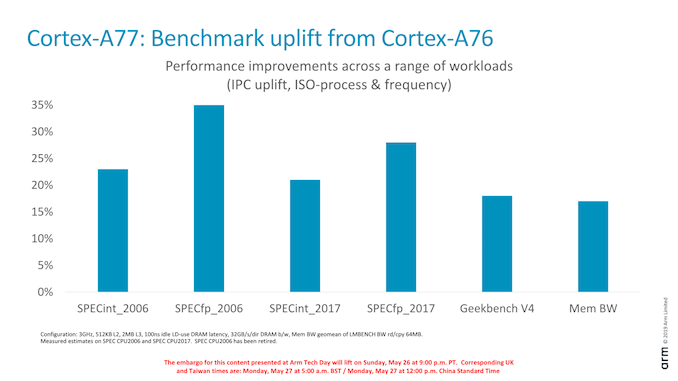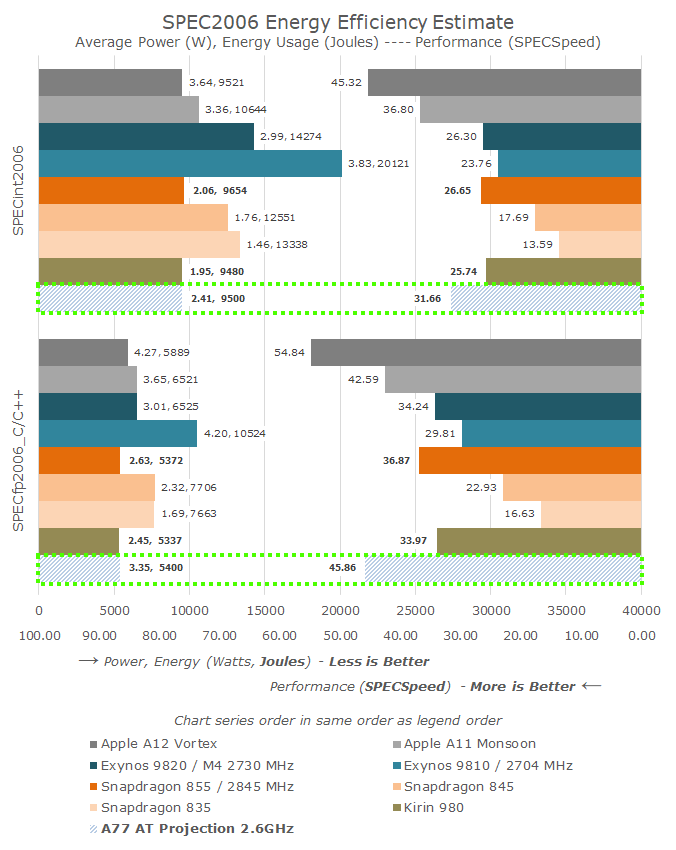Arm's New Cortex-A77 CPU Micro-architecture: Evolving Performance
by Andrei Frumusanu on May 27, 2019 12:01 AM ESTPerformance Targets: 20-35% Better IPC
The Cortex-A77 saw some interesting microarchitectural changes that promise to increase performance. The question now remains where exactly the targeted performance gains will end up at?
In terms of published performance improvements, Arm opted to stay with SPEC2006, 2017, GeekBench4 and LMBench memory bandwidth. Our focus here will be on SPEC2006 as it’s still the most relevant benchmark among the set for mobile.
On SPECint2006, the A77 promises around a 23% IPC increase, while SPECfp2006 claims a more staggering 35% boost. The 23% increase for integer workloads was more or less in line with what we expected of the CPU core, however the 30-35% increase for FP workloads I must admit came as quite a surprise, particularly since we haven’t seen any significant changes on the FP execution units of the core. An explanation here would be that SPEC’s FP test suite is more memory intensive than the integer suite, and the Cortex-A77’s various microarchitectural improvements would be more visible in these workloads.
Last year I had made performance and efficiency projections for the A76 at two frequency points, and I ended up being quite close to where the Kirin 980 and Snapdragon 855 ended up landing. For the Cortex-A77, things should be a lot more straightforward to project as we won’t see major process node changes in the next generation 7nm SoCs.
Baselining on the current results of the Kirin 980, I simply extrapolated performance based on the published IPC increases for a theoretical 2.6GHz Cortex-A77 SoC. It’s to be noted that although Arm this year again talks about 3GHz target frequencies for the A77, I’m not expecting vendors to quite reach this frequency in upcoming SoCs, thus the 2.6GHz projection.
In terms of performance, the integer suite would see some solid improvement, however the floating-point results are a lot more interesting. If correct, the A77 would exceed the FP performance of Apple’s A11 and make for quite a big generational push even though we’re not expecting big process node improvements. It’s to be noted though that the A77 will have to compete with Apple’s A13 later this year as well as next-gen M5 cores from Samsung.
Arm promises energy efficiency of the A77 will remain the same as current-gen A76 SoCs. Thus at peak performance, both CPU cores would use the same amount of energy to complete a set workload. The increased performance of the A77 would however have one drawback: Increased power usage, linear with the increased performance figures. This latter increased power usage would seemingly reach levels where running more than two cores at peak frequency would be more problematic in a mobile SoC. Luckily, most vendors have moved on from 4 full-speed big cores to 2+2 or 3+1 designs where there’s only one or two high-power big cores.
It’s to be noted although we’re talking about big cores here, the A77 is said to be only 17% bigger than the A76 – still significantly smaller than the next best microarchitecture from the competition.
End Remarks
Overall the Cortex-A77 announcement today isn’t quite as big of a change as what we saw last year with the A76, nor is it as big a change as today’s new announcement of Arm’s new Valhall GPU architecture and G77 GPU IP.
However what Arm managed to achieve with the A77 is a continued execution of their roadmap, which is extremely important in the competitive landscape. The A76 delivered on all of Arm’s promises and ended up being an extremely performant core, all while remaining astonishingly efficient as well as having a clear density lead over the competition. In this regard, Arm’s major clients are still heavily focusing on having the best PPA in their products, and Arm delivers in this regard.
The one big surprise about the A77 is that its floating point performance boost of 30-35% is quite a lot higher than I had expected of the core, and in the mobile space, web-browsing is the killer-app that happens to be floating point heavy, so I’m looking forward how future SoCs with the A77 will be able to perform.
But even in the integer workloads a 20-25% IPC gain is absolutely marvellous improvement, and we do trust Arm to be able to maintain energy efficiency of the A76. Power will go up slightly, but I think the industry has shown that mobile devices today handle at least two higher power cores properly, so future SoCs should continue with big+middle+little CPU configurations.
Coming A77 SoCs from vendors are expected to still be 7nm – Qualcomm and HiSilicon are the two obvious leading customers that would adopt the core and I’m expecting similar timeframes as last generation’s chipsets. For now- Arm’s delivering on their promised 20-25% yearly CAGR and we believe this to continue for the foreseeable next few generations.












108 Comments
View All Comments
saylick - Monday, May 27, 2019 - link
All this hype about the large cores... Where's the love for an improved A55 with better perf/W without considering process benefits?Wilco1 - Monday, May 27, 2019 - link
Since the performance gap with the big cores widens so quickly, increasing performance of the little cores seems more important than further increasing perf/W. Note this years's 7+nm and next year's 5nm will help perf/W already.Meteor2 - Monday, June 3, 2019 - link
The smaller cores sit in the background doing background stuff. Work/energy is the key metric for them, and A55 is the best. It's tough to improve; A76 and A77 only match A55 on that score, at besteastcoast_pete - Monday, May 27, 2019 - link
While I get the focus of the article and the comments here on what this means for smartphones, I think this is even bigger for efforts by Qualcomm and Huawei to break into the ultraportable market. I think that's what the 3 GHz target frequency ARM mentioned is for. The A76-based large Snapdragon chip is already a promising alternative to Intel's low-power lineup, so the evolutionary step up of the A77 likely makes it even more attractive. As for Huawei, it'll depend on how much of the tech has already been transferred from ARM, and how badly China will want a "home grown" (of sorts) alternative to Intel.pugster - Tuesday, May 28, 2019 - link
Unless there is some settlement in the trade talks where Huawei can work with ARM again, I don't think Huawei will release an SOC with an A77 in it. Since Huawei has an architecture license from ARM already they could release optimized ARM soc that could rival the A77.GTan - Monday, May 27, 2019 - link
"Qualcomm has proclaimed a 45% leap in CPU performance compared to the previous generation Snapdragon 855 with Cortex-A75 cores, the biggest generational leap ever."There is a typo. It's the Snapdragon 845 with the Cortex A-75 cores, not the Snapdragon 855.
NetMage - Monday, May 27, 2019 - link
Perhaps the typo is A-75 should be A-76?Andrei Frumusanu - Tuesday, May 28, 2019 - link
Yes, corrected.ksec - Monday, May 27, 2019 - link
So basically A77 7nm SoC will be about as fast as an 10nm A10 from Apple.Or in other words, if Apple discontinued iPhone 7 this year and lower the iPhone 8 price as their entry model, the iPhone 8 will as fast or faster than 99% of the Android Phones on the market.
Wilco1 - Monday, May 27, 2019 - link
Cortex-A77 will match or beat A11. Cortex-A76 already scores around 3600 on GB4, so an extra 18% gives around 4300, right at the top end of A11.